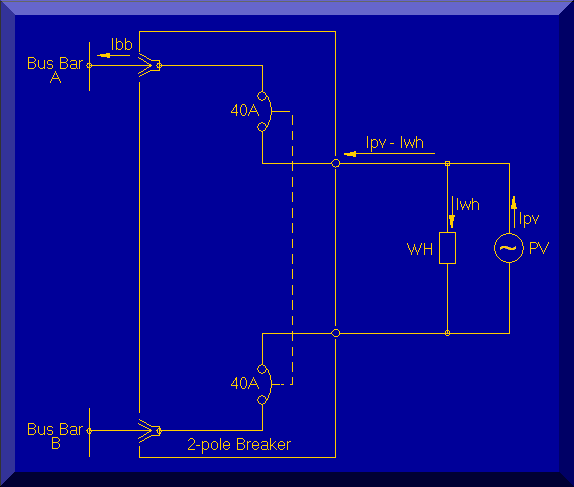Circuit Breaker Failures
August 26, 2003
After operating normally for 10 months, our photovoltaic generating plant shut down at 12:04 PM. I was out of town but the next day I tracked the problem to a failed circuit breaker. The generating plant delivers power to the panel bus through two 40-ampere breaker poles that are half of a quad. The other half is a 30-ampere pair for the water heater.
There appears to be a bridging conductor that rests on the two bus bar leaf contacts. Internally, one leaf feeds a 40-ampere breaker, the other leaf feeds a 30-ampere breaker. Photo below shows the failed section on the right, and the intact section for the other breakers on the left. The bridging conductor is visible cantilevered over the contact leaf on the right side of the intact section.
This bridge is probably an indexing mechanism for seating the breaker onto the bus bar. It is not fastened to the leaf contacts in any way and I don't believe it is intended to be a conductor.

The production log indicates power delivery at the time of failure was 26.6 amperes at 240 volts. This current would normally flow to the bus bar via the failed leaf contact on the right. It is not known if the water heater was drawing power at the time, but if it was the load would be 19 amperes and would flow from the bus bar via the failed leaf contact on the left.
August 27, 2003
I inspected the bus bar, which didn't appear damaged but was stained by vapors from the fused plastic. I polished the bus bar contact area and installed a new quad breaker. The generating plant operated normally for the rest of the day with solar production levels below those of peak hours.
August 28, 2003
The generating plant shut down at 1:52 PM, this time from a load of 25.3 amperes. The new breaker had failed in exactly the same way as the first one.

Here's the problem
I believe the problem is poor contact between the bus bar and the two loads, each served by a single leaf contact. This would cause excessive heating and oxidation of the contacts, and forcing some current to the bridging conductor. Eventually the current reached a level sufficient to fuse the bridge. Here's a diagram:

The issue is heavy current flowing through a single leaf. This occurs twice at each bus bar connection. Presuming the water heater load was 19 amperes and the PV system current was 26 amperes, the bus bar connection would suffer the heating effect of 45 amperes.
Solving the problem
I again cleaned the bus bar contacts, greased them with NO-OX, and replaced the second failed quad breaker with a 2-pole 40-ampere breaker. I fabricated a pair of very sanitary Y cable splices to merge the water heater and generating plant conductors into the 2-pole breaker. This is a much better arrangement for two reasons: First, the 2-pole breaker contacts are formed from a single piece of metal and effectively double the bus bar contact area for a given current level. Second, the generating plant and water heater currents are summed in a very stout connection outside of the breaker, and only the resultant difference current flows to or from the bus bar.
This configuration seems to be surviving the loads. Here's a diagram:

The current in the bus bar contacts will be the vector sum of water heater and PV currents. If, for example, the water heater load is 19 amperes and the PV system happens to be delivering 19 amperes, there will be no current flowing to or from the bus bar. The greatest current will flow through the contacts when the PV system delivers its maximum of about 31 amperes while the water heater is off. And in contrast to the quad arrangement, this current is carried by two leaf contacts.
Warning!
There were other things to consider before implementing this solution. Remembering that the primary service provided by a circuit breaker is to protect the conductors, it is mandatory that the water heater wiring be adequate for the breaker that now serves it. Fortunately I had wired the water heater circuit with #8 THHN, so it was acceptable to protect it with a 40-ampere breaker. But the wire must also be protected from overload that could be delivered by the PV system. This is nicely done by another 40-ampere breaker in the combining load center at the PV system.
I suspected the bus bar has been damaged, so I tried to locate a replacement. The Siemens/Murry rep advised that replacement bus bars are not sold due to some kind of UL consideration. I would have to buy a new load center and swap out the bus bars.
Conclusion
Don't use quad breakers for loads above 20 amperes.